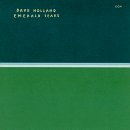Emerald Tears - a Masterpiece
Ronan Guilfoyle | Dublin, Ireland | 03/31/2009
(5 out of 5 stars)
"This is a revolutionary recording - it revealed a new way to pay the bass, a way that was both in the tradition yet innovative in all kinds of ways. First of all the idea of a solo bass recording was in itself incredibly forward thinking. If you're going to make a solo bass recording, and you're not going to use any studio/multi-tracking/electronic techniques, then you'd better have a lot of creative and technical weaponry to bring with you! Because you're armed with just four strings, your technique and your imagination. And Dave more than rises to that challenge - Emerald Tears is a tour de force of both technique and imagination. But even leaving aside this fantastic musical achievement, another thing that's really interesting about Emerald Tears from a bassists point of view, is that Dave charted an individual course between the two major streams of modern bass playing, one which was independent of, yet referential to both.
In the early 1960s the tradition of bass playing in jazz split into two major streams - one following in a direct line from Jimmy Blanton and including players such as Ray Brown, Paul Chambers and Ron Carter. The other stream was instigated in the late 50s and early 60s by Scott La Faro who showed a generation of bassists a whole new way of playing the instrument and interacting with the other musicians. After La Faro's premature death this tradition was continued by such players as Gary Peacock, Chuck Israels and Eddie Gomez. Bassists who appeared in the mid-60s and afterwards would usually identify with one or the other school of bass playing, and the influence of that school could usually be clearly heard. But what Dave Holland did was show another way - one that used the rhythmic power and resonance of the traditional school, while exploiting the innovations of the later one.
But not only did he draw on these two traditions, he also brought a bunch of original things of his own to the bass playing table - extended arco techniques, extensive use of motifs, and an incredibly developed rhythmic sense. In this latter regard, the use of rhythm on Emerald Tears is extraordinary - at times, in a kind of extended recognition of one of its major functions in jazz, the bass is almost used like a percussion instrument. I've never heard a more powerful exposition of the rhythmic possibilities of the bass in creative music than on Emerald Tears. Small motifs are developed, extended and mutated through the use of rhythm, and the rhythmic possibilities of an instrument with such a large body and long string length are exploited to the full.
And this is one of the things I enjoy most about Emerald Tears - it is a BASS recording! So often bassists try and emulate other instruments in terms of soloing - the bebop masters who translated Charlie Parker's language for the bass, the modern electric players who are as fleet as any guitarist or saxophonist. But this recording could only have been made by a bassist - huge amounts of it are untranslate-able to any other instrument. On Emerald Tears Dave Holland not only puts together a great programme of music that holds the attention of the listener for all of its 40+ minutes, but he also makes a recording that celebrates the bass as a unique instrument with qualities and characteristics that can only be found on the bass. For that alone all jazz bassists should be grateful."


 Track Listings (8) - Disc #1
Track Listings (8) - Disc #1